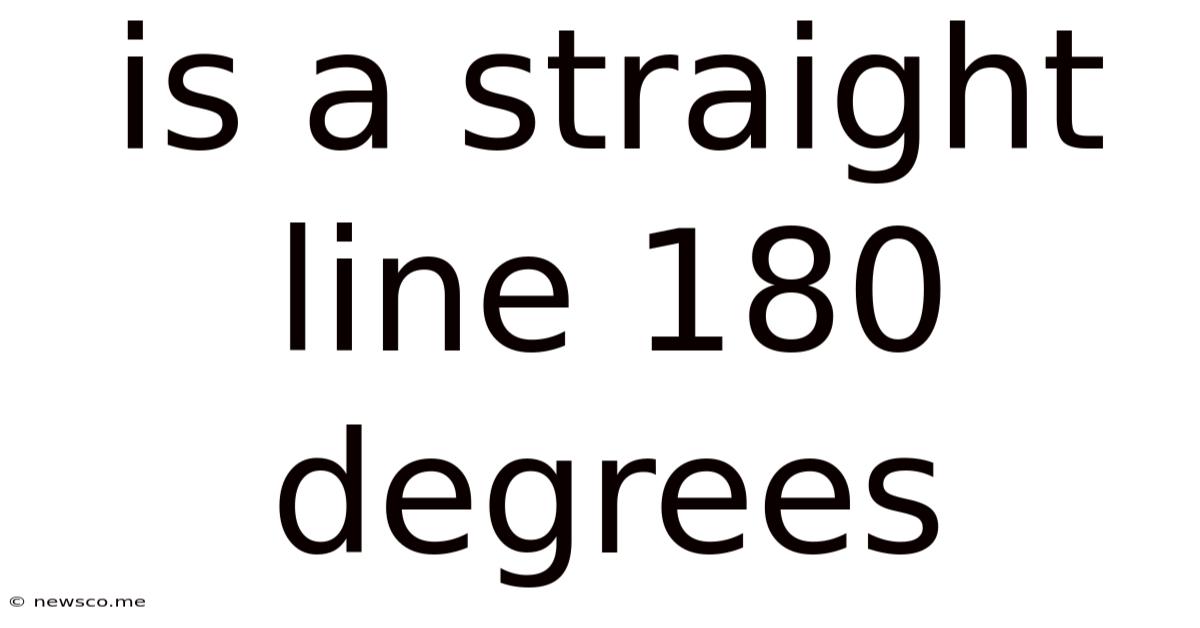Is A Straight Line 180 Degrees
News Co
Apr 15, 2025 · 5 min read

Table of Contents
Is a Straight Line 180 Degrees? A Deep Dive into Angles and Geometry
The simple statement, "a straight line is 180 degrees," is a cornerstone of geometry, yet understanding its implications requires a deeper exploration of angles, their measurement, and the fundamental principles governing lines and shapes. This article will delve into the concept, exploring its mathematical basis, practical applications, and addressing potential misconceptions.
Understanding Angles: The Foundation of Measurement
Before we definitively answer the question, let's establish a clear understanding of angles. An angle is the figure formed by two rays (or line segments) sharing a common endpoint, called the vertex. Angles are typically measured in degrees, a unit derived from dividing a circle into 360 equal parts. Each of these parts represents one degree (1°).
Types of Angles: A Quick Overview
Several types of angles exist, each defined by their measure:
- Acute Angle: An angle measuring less than 90°.
- Right Angle: An angle measuring exactly 90°. These are often represented by a small square at the vertex.
- Obtuse Angle: An angle measuring greater than 90° but less than 180°.
- Straight Angle: An angle measuring exactly 180°. This is where our focus lies.
- Reflex Angle: An angle measuring greater than 180° but less than 360°.
Defining a Straight Line: More Than Just a Visual Concept
A straight line is a fundamental geometric concept. It's often described as the shortest distance between two points and extends infinitely in both directions. While intuitively simple, its mathematical definition is more rigorous. It's a one-dimensional object with no curvature, existing within a plane (a flat, two-dimensional surface).
The Straight Line and 180 Degrees: The Connection
The statement "a straight line is 180 degrees" connects the concept of a straight line with the measurement of a straight angle. Imagine a straight line. Now, consider a point on that line. If we draw two rays originating from this point, extending along the line in opposite directions, they form a straight angle. This angle's measure is precisely 180 degrees. This is not an arbitrary assignment; it's a direct consequence of how angles are defined and measured within a circular system.
Mathematical Proof and Geometric Demonstrations
We can demonstrate the 180-degree relationship using various geometric principles.
Using Supplementary Angles
Two angles are supplementary if their measures add up to 180°. Consider a straight line intersected by another line. This intersection creates four angles. The angles on either side of the intersection point along the straight line are supplementary. Since they form a straight angle, their sum is always 180°. This is a classic geometric theorem.
Using Protractors: A Practical Demonstration
A protractor is a tool used to measure angles. By placing a protractor on a straight line and aligning its center with a point on the line, we can physically measure the angle formed by the two rays extending along the line in opposite directions. The measurement will always be 180 degrees, reinforcing the relationship.
Cartesian Coordinate System: Algebraic Representation
In a Cartesian coordinate system, a straight line can be represented by a linear equation (e.g., y = mx + c). While this doesn't directly measure the angle in degrees, it illustrates the linearity and uninterrupted nature of the line, which inherently corresponds to a 180-degree angle.
Applications in Various Fields
The concept of a straight line equating to 180 degrees isn't just a theoretical construct; it finds extensive application across various fields:
Surveying and Mapping
Surveyors rely heavily on angle measurements for accurate land surveying and map creation. Understanding that a straight line represents 180 degrees is crucial for determining distances, directions, and property boundaries.
Construction and Engineering
In construction and engineering, the precise measurement of angles is critical for building structures and infrastructure. Understanding the 180-degree relationship ensures the accuracy of designs and blueprints.
Computer Graphics and Animation
In computer graphics and animation, creating realistic images and movements requires meticulous control over angles and lines. The 180-degree representation of a straight line forms a foundation for rendering and manipulating digital objects.
Navigation and Flight
Pilots and navigators rely on precise angle measurements for navigation. Understanding the concept of straight lines and their angular representation is critical for accurate route planning and safe flight operations.
Addressing Potential Misconceptions
While the concept is relatively straightforward, certain misconceptions can arise:
Confusing Straight Lines with Straight Angles
Some may confuse a straight line with a straight angle. While closely related, they are distinct concepts. A straight line is an infinite one-dimensional entity, whereas a straight angle is a specific measure (180 degrees) formed by two rays sharing a common endpoint.
Limitations of Visual Perception
Visual perception can be deceiving. What might appear as a straight line might have a minute curvature imperceptible to the naked eye. Precise measurement tools are essential for accurate determination.
Conclusion: The Significance of a Fundamental Concept
The statement, "a straight line is 180 degrees," is more than just a simple geometric fact. It's a fundamental concept underpinning a vast array of applications in mathematics, science, engineering, and technology. Understanding its mathematical basis, practical implications, and potential misconceptions solidifies our grasp of geometric principles and their real-world significance. From surveying land to designing buildings and creating realistic computer graphics, this simple yet powerful relationship plays a crucial role in shaping our world. The connection between straight lines and 180-degree angles is a testament to the elegant precision of mathematical concepts and their pervasive influence on our understanding of the world around us. Its simplicity belies its profound importance in various fields, emphasizing the power of fundamental geometric principles.
Latest Posts
Related Post
Thank you for visiting our website which covers about Is A Straight Line 180 Degrees . We hope the information provided has been useful to you. Feel free to contact us if you have any questions or need further assistance. See you next time and don't miss to bookmark.